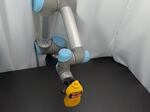
A team of computer scientists and engineers at the University of Washington developed a new way to design and 3D print robotic grippers customized to pick up an array of different shaped objects, including a mustard bottle.
Jeffrey Lipton, University of Washington
Jeffrey Lipton is an assistant professor in the mechanical engineering department at the University of Washington. He is also an expert at using 3D printers in novel ways, including hacking the technology nearly a decade ago to make pizza and other edible creations.
And while 3D printing technology has gotten much more accessible and sophisticated, other applications of automation, by comparison, seem stuck in their ways. Take, for example, a modern assembly line that uses robotic arms to sort packages on a conveyor belt or bolt a screw in place on a car engine. It turns out that even a state-of-the art assembly line can’t easily pivot to manufacture a new set of objects with different shapes, as Lipton discovered in the early days of the pandemic.
Two years ago, Lipton was part of a team of computer scientists and engineers at the University of Washington tasked with helping the federal government manufacture personal protective equipment like face masks for frontline health workers. Automotive giant Ford also assisted on the project but had to bring in workers to manufacture the PPE because it proved too costly and time-consuming to set up robotic arms which could pick up and move a face shield as easily as a steering wheel.
“Robots do the same task over and over again,” Lipton said.
“But if you want to change from going from producing cars like Ford did to producing face shields, you can’t take your capital equipment and just turn it on a dime.”
So Lipton and his colleagues at the University of Washington turned to a 3D printer to help solve this problem.
But first they had to strip the mechanics of picking up an object like a mug or a banana to its basics.
“It’s really an enabling component of all of your automation inside of a factory,” Lipton said. “You have to be able to pick up an item in order to be able to manipulate it, to scan it, to do other things with it.”
Lipton and his team used computer-aided design models of different objects ranging from household items like a mustard bottle and drill to more complex shapes, like one resembling a toy piano with a curved top. They then used software to identify the three best points on that object that a robotic hand, or gripper, could reach for and grab without knocking it over.
“Often, we like to use a lot more contacts when we’re picking something up. But if you’re very careful in picking the right three points, it’ll balance just right,” Lipton said.
The computer also generated a set of instructions that could be fed into a 3D printer to make a plastic, three-fingered, hand-like gripper customized to the shape of the object being picked up. It also lacked any suction cups or motorized parts to pinch down on surfaces when securing a grip.
“We can figure out the exact shape to pick up an object. We can do it without any additional components we need to install,” Lipton said.
“We could retool an entire robot by just giving it access to a $200 3D printer to print off components,” he added.
In a lab at the University of Washington, Lipton and his team measured the success of the 3D-printed grippers in not only picking up but rotating objects like a Stanford bunny, 180 degrees. Of the 22 different shapes, only a “funkily-curved chair” proved too tough to grab and rotate consistently without dropping.
Still, Lipton is encouraged by the results. And with more shapes comes more familiarity with learning the robotic task at hand.
“What we need to do is throw more objects at it… to really see what it would take to scale this up from picking up 20 objects to 2,000 to two million objects a day.”
Jeffrey Lipton spoke to “Think Out Loud” host Dave Miller. Click play to listen to the full conversation:
